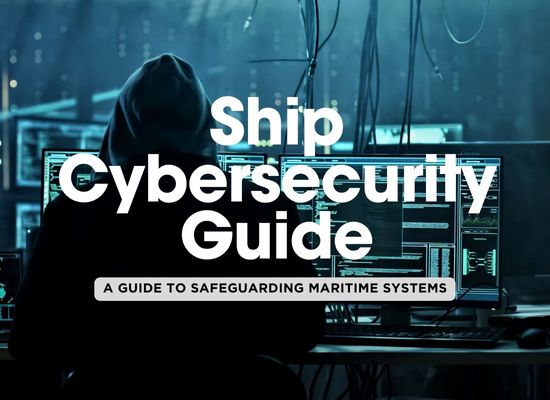The Ultimate Maritime Cybersecurity FAQ

In today’s interconnected maritime industry, safeguarding digital assets is as crucial as securing physical ones. With the rise of cyber threats targeting vessels and port operations, understanding maritime cybersecurity is essential for maintaining operational integrity and safety at sea. This comprehensive FAQ addresses key concerns and best practices to help maritime professionals navigate the complex landscape of cyber risk management.
- What is maritime cybersecurity?
- Why is cybersecurity important in the maritime industry?
- What are common cyber threats facing the maritime sector?
- How can shipowners and operators mitigate cyber risks?
- What regulations govern maritime cybersecurity?
- What are the key challenges in implementing maritime cybersecurity?
- How does cybersecurity affect ship navigation systems?
- What is the role of crew training in cybersecurity?
- How can ports enhance their cybersecurity measures?
- What is the impact of ransomware on the maritime sector?
- How do shipboard systems remain vulnerable to cyberattacks?
- What is GPS spoofing, and how does it affect ships?
- How can vessel owners ensure compliance with IMO cybersecurity guidelines?
- What role do firewalls play in maritime cybersecurity?
- How can fleet operators detect a cyber breach?
- What is phishing, and how does it target maritime operations?
- How can cyber insurance help shipowners?
- Are Automatic Identification Systems (AIS) secure from cyber threats?
- What are “air-gapped” systems, and how do they enhance cybersecurity?
- How can shore-based teams support cybersecurity for vessels?
- What is ransomware, and how can it disrupt maritime operations?
- How does multi-factor authentication (MFA) enhance cybersecurity on ships?
- Can outdated hardware increase cyber risks?
- What is the role of endpoint protection in maritime cybersecurity?
- How can maritime organizations handle cybersecurity incidents effectively?
- How does the Internet of Things (IoT) increase cybersecurity risks in the maritime industry?
- Can antivirus software fully protect maritime systems?
- What are the risks of remote access to ship systems?
- How do cyberattacks impact a ship’s compliance with international regulations?
- What future trends in maritime cybersecurity should shipowners watch for?
1️⃣ What is maritime cybersecurity?
Maritime cybersecurity involves protecting the information technology (IT) and operational technology (OT) systems used in the maritime sector from cyber threats. This includes safeguarding shipboard systems, port infrastructure, and communication networks against unauthorized access, data breaches, and other cyber incidents.
Key Components:
- IT Systems: Administrative networks, email servers, and databases.
- OT Systems: Navigation systems, engine controls, and cargo management systems.
- Communication Networks: Satellite links, radio communications, and Automatic Identification Systems (AIS).
2️⃣ Why is cybersecurity important in the maritime industry?
The maritime industry relies heavily on digital systems for navigation, cargo handling, and communication. Cyber incidents can disrupt operations, compromise safety, and lead to significant financial losses. For example, malware attacks have previously caused substantial operational disruptions to major shipping lines.
Potential Impacts of Cyber Incidents:
- Operational Disruptions: Delays in cargo delivery and port operations.
- Safety Risks: Compromised navigation systems leading to accidents.
- Financial Losses: Costs associated with downtime, repairs, and ransom payments.
3️⃣ What are common cyber threats facing the maritime sector?
The maritime sector faces various cyber threats, including:
- Phishing Attacks: Deceptive emails aimed at stealing sensitive information.
- Malware: Malicious software that disrupts systems or steals data.
- Ransomware: Malware that encrypts data, demanding payment for its release.
- GPS Spoofing: Manipulating GPS signals to mislead navigation systems.
- AIS Manipulation: Tampering with the Automatic Identification System to alter vessel information.
4️⃣ How can shipowners and operators mitigate cyber risks?
Implementing robust cybersecurity measures is vital. Key steps include:
- Conducting Regular Risk Assessments: Identify vulnerabilities in IT and OT systems.
- Implementing Access Controls: Ensure only authorized personnel have system access.
- Regular Software Updates: Keep systems updated to protect against known vulnerabilities.
- Crew Training: Educate staff on cybersecurity best practices and threat awareness.
- Incident Response Planning: Develop and regularly update plans to respond effectively to cyber incidents.
5️⃣ What regulations govern maritime cybersecurity?
Several international and national regulations address maritime cybersecurity:
- International Maritime Organization (IMO): Requires cyber risks to be addressed in Safety Management Systems as part of operational safety.
- United States Regulations: The U.S. Coast Guard mandates cyber incident reporting and security measures for vessels and port facilities.
- European Union Directives: The NIS2 Directive mandates enhanced cybersecurity measures across critical infrastructure sectors, including maritime.
6️⃣ What are the key challenges in implementing maritime cybersecurity?
Implementing cybersecurity in the maritime industry comes with unique challenges, such as:
- Legacy Systems: Many ships rely on outdated systems that are difficult to secure.
- Limited Awareness: Crew members may not recognize cyber threats or understand their implications.
- Remote Operations: Ships often operate in isolated areas with limited IT support.
- Integration Complexity: Aligning IT and OT security measures can be technically challenging.
Solution: Regular crew training and system audits can effectively address these challenges.
7️⃣ How does cybersecurity affect ship navigation systems?
Navigation systems, including GPS and Electronic Chart Display and Information Systems (ECDIS), are vulnerable to threats like GPS spoofing and malware attacks. A compromised system can lead to misrouting, collisions, or grounding.
Recommendation: Use encrypted communication channels for navigation updates and back up critical data on secured storage devices.
8️⃣ What is the role of crew training in cybersecurity?
Crew training is vital for maintaining robust cybersecurity. Trained personnel can identify phishing attempts, follow secure operational procedures, and respond swiftly to incidents.
Best Practice: Implement simulated cyber-attack exercises to keep the crew prepared and vigilant.
9️⃣ How can ports enhance their cybersecurity measures?
Ports can bolster cybersecurity by:
- Installing intrusion detection systems.
- Regularly updating software and hardware.
- Segregating networks to prevent lateral movement of threats.
Insight: Collaborating with local and international maritime authorities for real-time threat intelligence sharing can further enhance security.
🔟 What is the impact of ransomware on the maritime sector?
Ransomware attacks can disrupt operations by encrypting critical data and demanding payments, leading to delays, financial losses, and reputational damage.
Preventative Measure: Maintain regular data backups on secure, offline storage systems to recover operations quickly without paying ransoms.
1️⃣1️⃣ How do shipboard systems remain vulnerable to cyberattacks?
Shipboard systems often rely on a mix of IT and OT networks, creating vulnerabilities. Common risks include:
- Unsecured Wi-Fi Networks: Open or weakly encrypted networks onboard.
- Poor Password Practices: Default passwords or lack of regular updates.
- No Real-Time Monitoring: Limited detection capabilities for unusual activities.
Actionable Advice: Invest in intrusion detection systems and enforce strong password policies.
1️⃣2️⃣ What is GPS spoofing, and how does it affect ships?
GPS spoofing involves falsifying GPS signals, tricking a ship’s navigation systems into believing it is in a different location. This can lead to:
- Incorrect Routing: Ships veering off-course.
- Safety Risks: Increased collision or grounding chances.
- Economic Losses: Delayed cargo deliveries.
Precaution: Use multi-layered navigation tools, such as radar and AIS, to cross-verify positioning data.
1️⃣3️⃣ How can vessel owners ensure compliance with IMO cybersecurity guidelines?
The IMO mandates addressing cybersecurity risks as part of Safety Management Systems (SMS). Compliance steps include:
- Conducting risk assessments for all digital systems.
- Integrating cybersecurity measures into SMS documentation.
- Training crew on cyber hygiene practices.
Checklist: Regularly update SMS to reflect the latest cybersecurity protocols.
1️⃣4️⃣ What role do firewalls play in maritime cybersecurity?
Firewalls act as barriers between trusted internal networks and untrusted external sources, filtering traffic to block malicious activities. They protect:
- Ship-to-Shore Communication: Prevent unauthorized access during data exchanges.
- Navigation Systems: Shield critical systems from external tampering.
Optimization Tip: Configure firewalls to block all non-essential traffic and regularly update settings.
1️⃣5️⃣ How can fleet operators detect a cyber breach?
Detecting cyber breaches early can minimize damage. Indicators include:
- Unusual System Behavior: Sudden slowdowns or unexpected pop-ups.
- Unauthorized Access Logs: Unrecognized login attempts.
- Data Irregularities: Missing or altered files.
Proactive Measure: Employ monitoring software to track system activity and set up alerts for suspicious behaviors.
1️⃣6️⃣ What is phishing, and how does it target maritime operations?
Phishing is a cyberattack where malicious actors send deceptive emails or messages to trick recipients into revealing sensitive information. In maritime operations, it can target:
- Crew Emails: Gaining access to ship systems through compromised accounts.
- Port Authorities: Manipulating communication for unauthorized cargo releases.
- Financial Transactions: Redirecting payments to fraudulent accounts.
Preventive Measure: Educate crew to recognize phishing attempts and verify suspicious emails before responding.
1️⃣7️⃣ How can cyber insurance help shipowners?
Cyber insurance provides financial protection against cyber incidents, covering costs such as:
- Incident Response: Hiring experts to address breaches.
- Business Interruptions: Loss of revenue during downtime.
- Legal Costs: Addressing regulatory fines or lawsuits.
Tip for Coverage: Ensure your policy includes maritime-specific risks like GPS spoofing or ransomware targeting vessel systems.
1️⃣8️⃣ Are Automatic Identification Systems (AIS) secure from cyber threats?
AIS, used to broadcast vessel location and identity, is vulnerable to hacking and spoofing. Cyber attackers can manipulate AIS to:
- Falsify Vessel Data: Alter ship names, destinations, or positions.
- Create Phantom Ships: Introduce fake vessels into the network.
- Confuse Traffic Management: Leading to navigation errors.
Recommendation: Combine AIS data with radar systems and restrict access to AIS configurations.
1️⃣9️⃣ What are “air-gapped” systems, and how do they enhance cybersecurity?
Air-gapped systems are isolated from external networks, reducing exposure to cyber threats. In the maritime context, they are used for:
- Navigation Equipment: Ensuring GPS and radar operate independently of the internet.
- Critical OT Systems: Protecting propulsion controls from malware infiltration.
Maintenance Advice: Regularly check air-gapped systems to prevent vulnerabilities from physical access or outdated software.
2️⃣0️⃣ How can shore-based teams support cybersecurity for vessels?
Shore-based teams play a critical role by:
- Monitoring Systems Remotely: Using real-time alerts for unusual activity.
- Providing Rapid Support: Addressing cyber incidents when ships are at sea.
- Standardizing Security Protocols: Ensuring vessels operate under unified cybersecurity measures.
Collaboration Strategy: Maintain clear communication between ship and shore teams to enhance response readiness.
2️⃣1️⃣ What is ransomware, and how can it disrupt maritime operations?
Ransomware is malicious software that locks or encrypts data, demanding payment for its release. In maritime operations, ransomware can:
- Disable Navigation Systems: Forcing manual operation or grounding.
- Delay Cargo Delivery: Disrupting schedules and causing financial losses.
- Expose Sensitive Data: Risking reputational harm and legal issues.
Prevention Tip: Use regular backups stored offline to recover data without paying ransoms.
2️⃣2️⃣ How does multi-factor authentication (MFA) enhance cybersecurity on ships?
MFA requires multiple verification steps to access systems, such as passwords and one-time codes. It enhances security by:
- Preventing Unauthorized Access: Even if passwords are compromised.
- Securing Communication Systems: Protecting ship-to-shore data exchanges.
- Reducing Insider Threats: Adding layers of protection to sensitive systems.
Implementation Advice: Enforce MFA across all IT and OT systems for maximum security.
2️⃣3️⃣ Can outdated hardware increase cyber risks?
Yes, outdated hardware often lacks the capability to run modern security protocols, exposing ships to cyber risks. Risks include:
- Unpatched Vulnerabilities: Exploitable security flaws.
- Incompatibility with New Software: Creating operational inefficiencies.
- Higher Maintenance Costs: Diverting resources from cybersecurity investments.
Solution: Replace outdated hardware regularly and ensure compatibility with the latest software updates.
2️⃣4️⃣ What is the role of endpoint protection in maritime cybersecurity?
Endpoint protection secures devices like computers, tablets, and communication systems onboard ships. Benefits include:
- Real-Time Threat Detection: Blocking malware before it spreads.
- System Integrity Monitoring: Identifying unauthorized changes.
- Remote Management: Allowing shore teams to apply updates and patches.
Proactive Measure: Use endpoint protection software with centralized management for fleet-wide security.
2️⃣5️⃣ How can maritime organizations handle cybersecurity incidents effectively?
Effective incident handling involves:
- Preparation: Developing a comprehensive incident response plan.
- Detection: Using monitoring tools to identify threats early.
- Containment: Isolating affected systems to prevent spread.
- Recovery: Restoring operations from secure backups.
Best Practice: Regularly test incident response plans with drills to ensure readiness.
2️⃣6️⃣ How does the Internet of Things (IoT) increase cybersecurity risks in the maritime industry?
IoT connects various shipboard systems, improving efficiency but introducing vulnerabilities. Risks include:
- Unauthorized Access: Hackers can infiltrate connected devices.
- Data Breaches: Sensitive information transmitted over unsecured networks.
- Malware Propagation: IoT devices becoming entry points for attacks.
Mitigation Strategy: Secure IoT devices with strong passwords, regular updates, and network segmentation.
2️⃣7️⃣ Can antivirus software fully protect maritime systems?
Antivirus software is essential but not sufficient on its own. It protects against:
- Known Threats: Detecting and removing common malware.
- Real-Time Scans: Monitoring files and applications for suspicious behavior.
Limitations: It cannot prevent sophisticated attacks like zero-day exploits or advanced persistent threats.
Recommendation: Pair antivirus with firewalls, intrusion detection systems, and regular security audits.
2️⃣8️⃣ What are the risks of remote access to ship systems?
Remote access can be convenient but introduces risks, such as:
- Unauthorized Logins: Exploited through weak credentials.
- Data Interception: Sensitive data exposed during transmission.
- Malware Injections: Attackers using remote access points to spread threats.
Precaution: Use encrypted connections, such as VPNs, and restrict access to essential personnel only.
2️⃣9️⃣ How do cyberattacks impact a ship’s compliance with international regulations?
A cyberattack can compromise compliance by:
- Disabling Mandatory Systems: Such as ECDIS or AIS.
- Delaying Operations: Leading to fines for late arrivals or cargo mishandling.
- Failing Audits: Due to compromised safety management systems.
Compliance Advice: Regularly test cybersecurity measures to align with IMO and local regulations.
3️⃣0️⃣ What future trends in maritime cybersecurity should shipowners watch for?
Emerging trends to monitor include:
- AI-Powered Threat Detection: Leveraging machine learning to identify anomalies.
- Blockchain in Shipping: Securing supply chain transactions and reducing fraud.
- Cybersecurity as a Service (CaaS): Outsourcing security management to specialized providers.
Preparation Tip: Stay informed about technological advancements and integrate future-ready solutions into your operations.

Do you have a Maritime Product or Service that may be of interest to Shipowners? Tell us about it here!
Do you have feedback or insights? Please reach out to editor @ shipuniverse.com



